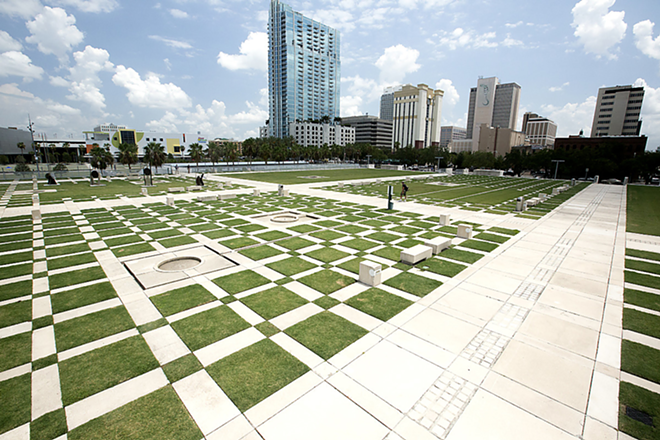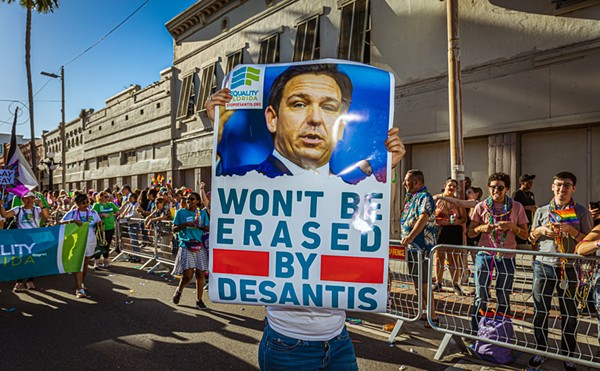On a blisteringly hot Saturday last March, thousands of people gathered in Tampa’s revitalized urban green, Curtis Hixon Park, to enjoy the first-ever Gasparilla Music Festival. Actually, two parks hosted the event — Curtis Hixon played host to the fest’s main stage just in front of the Hillsborough River, while two other stages were set in adjoining Kiley Garden, a park designed by world-renowned architect Dan Kiley back in 1988.
To see Tampa host a daytime music festival with such a high level of quality acts was exciting for music enthusiasts, as well as for those who just want downtown to prosper.
But it was extraordinarily warm that day, even for a March afternoon in Tampa. Former City Councilwoman Linda Saul-Sena said that at around 2:30 p.m., while blues-rocker Kaleigh Baker was performing, "people were climbing the wall" — her reference to the foot and a half or so of shade that was available at that particular moment.
Saul-Sena leads the vanguard of concerned citizens who say the festival could be enhanced next year with the phasing in of trees, making the park more aesthetically attractive and providing crucial cover from the unforgiving sun.
Kiley enthusiasts also would like to see the fountains from the original design restored, but that’s not their first priority. They’re also not asking for a handout. What these concerned citizens want is for the city to grant Kiley Garden local historic landmark status, enabling them to raise money for tree replacement via grants available to such preserved landmarks.
Adding more trees in Kiley is something that all of the players involved in this saga agree upon. But that’s where the consensus ends, as city officials are on record as being opposed to historic preservation.
To the garden's supporters, the resistance smacks of the same attitude that has plagued the park since Kiley created it simultaneously with architect Harry Wolfe’s construction of what is affectionately/derisively known as “the Beer Can Building” (aka Riverfront Tower) at the corner of Kennedy Boulevard and Ashley Drive some 24 years ago.
One argument made by Dennis Fernandez, the city’s historic preservation and urban design manager, is that Kiley simply hasn’t yet lasted the required length of time (traditionally 50 years).
But a report published nearly five years ago says that the park’s initial blueprint design by Dan Kiley was so original that it deserves such a ranking. Pressley Associates, a landscape architectural firm located in Cambridge, Mass., wrote that though the plaza was then barely two decades old, there was a provision in the National Register (Criteria Consideration G, specifically) that grants an exception for properties that have “achieved significance in the past 50 years due to their exceptional importance at the national, state or local level … NCNB Plaza (its official name) is of exceptional importance as a work of modern landscape architectural and is thus likely eligible for listing on the National Register.”
But the Pressley Associates report also says that to be eligible for National Historic Landmark status, such a facility must retain a high level of integrity, which is something critics say the current Kiley Garden absolutely lacks from its original design in 1988.
Dan Kiley worked on a number of notable projects before his death at the age of 91 in 2004, such as the Gateway Arch in St. Louis, the Ford Foundation’s headquarters and Lincoln Center in Manhattan and I.M. Pei’s East Building for the National Gallery of Art in Washington.
One of the new owners of Rivergate Tower, Dennis Udwin, said he was unaware of the push by advocates for Kiley Garden to attain landmark status for the park. He says he doesn’t have a problem with them applying.
“I think they should do more trees, but you have to be more sensitive from an architectural and landscaping architect’s point of view, so it doesn’t cause issues for us and the city and the parking garage,” he says.
Another reason Tampa doesn’t want to give the park historical status is that city officials say it goes hand in hand with NCNB Plaza, the official name of Rivergate Tower, which doesn’t want historic status. Kiley advocates say that’s fine — that Rivergate Tower isn’t going anywhere in the future, and doesn’t need the designation. But they’re not sure if that will be the case with Kiley.
To hear its supporters tell it, Kiley Garden has always been the Rodney Dangerfield of public parks in Tampa. In a recent edition of La Gaceta, Patrick Manteiga wrote, “There never was a heyday for the gardens,” before lambasting it as “gone, and we are okay if it is forgotten.”
Tampa Mayor Bob Buckhorn echoes Manteiga, saying, “It was a dysfunctional park. It never worked. It wasn’t the economic engine that it could be. It didn’t attract the type of use that it should.”

















